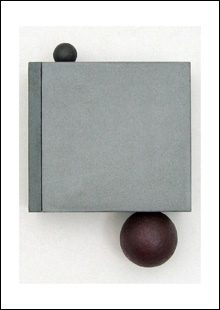
LOOK INSIDE: "Deep River," by Noriko
Sakanishi, 18.5" by 14", acrylic and mixed
media, 2007.
|
Noriko Sakanishi’s work offers the viewer very little and delivers a great deal. The simplicity of her imagery and the hermetic nature of her process compel the viewer to accept the work on its own terms, and reward the effort with a rich experience indeed.
In her current show, “Seeking Balance,” at the June Fitzpatrick Gallery at Maine College of Art in Portland, Sakanishi shows 22 of her signature wall constructions, plus a few small collages. These pieces demonstrate her sometimes uncanny ability to assemble basic shapes into works of emotional resonance and quiet beauty. These are mature, fully-developed works of art whose internal order gives them tangible intensity.
Sakanishi obscures how these pieces are made, and what they are made of. Are they metal, a casting, something built up or painted? It’s difficult to tell, which is instructive. Sakanishi’s work helps dispel the myth that an artist’s process is significant for the viewers’ experience of the work. This idea, born in the 1950s critical work of Harold Rosenberg, still has much currency but little validity. To paraphrase A.J. Liebling, the way to make art is well, and how you do it is your own business.
Sakanishi gives the viewer no convenient clues to interpretation. Thick squares are placed one atop the other, perhaps set off by a tilt, or surmounted by a hemisphere. A small ball may look like it came from a spherical hollow, or perhaps it didn’t. In “Reflection,” for instance, Sakanishi offers no systematic rule underlying the arrangement of 16 narrow gray-green rectangles with holes in their right ends on the left side of the piece, and nine similarly sized brick-red rectangles with holes in their left ends on the right side.
The internal logic of the arrangement of rectangles and hollows and hemispheres and blocks is readily apparent, but in a poetic, rather than rational, sense. Things are put together in ways that are coherent, even inevitable, but not predicated on any ordinary design sensibility. The color, surface, and arrangement are restrained in ways that imply more is going on than meets the eye. Taken together they become a solid yet somehow mysterious metaphor for an enigmatic reality that seems just beyond view.
“Reach” is a rectangle forty inches high by thirty wide, with a bronze-like hemispherical hollow set in a small square area near the top. Raised lines radiate out from the sides of the square area and travel down one side of the piece and back up the other side in a symmetrical pattern. The lines are dark edges in high relief set against a lighter, almost metallic background. It is the most symmetrical piece in the show, but it doesn’t induce the sense of safety that usually accompanies symmetric structure. Instead, the piece occupies the space around it and the viewers’ attention with a commanding presence, as if there were some great hidden mass somewhere behind it. There isn’t — it hangs there politely, like a painting.
Like her work, Sakanishi has been a solid, if sometimes quiet, presence in Maine art for nearly four decades (she graduated from Maine College of Art when it was still called the Portland School). But she has avoided the pitfalls that often come with trying to maintain artistic vitality, intensity, and integrity over a long span of years; she has not slid into self-repetition, academic sterility, or slavery to current fashions. This show is the latest in her long series of exhibitions demonstrating the special artistic focus that has always set her work apart.
"Seeking Balance" | by Noriko Sakanishi | through Oct 27 | at June Fitzpatrick Gallery at MECA, 522 Congress St, Portland | Tues-Sat noon-5 pm | 207.879.5742 x283
On the Web
June Fitzpatrick Gallery:| www.junefitzpatrickgallery.com
Email the author
Ken Greenleaf: ken.greenleaf@gmail.com